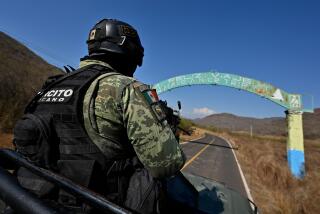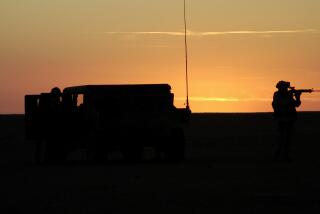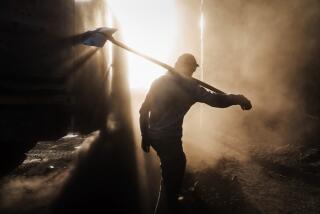IED threat shadows Marines’ every move
- Share via
Reporting from Nawa, Afghanistan — A long, dusty road under a bright blue Afghan sky. To the left, a stagnant irrigation canal; to the right, drying cornfields. Marines from Charlie Company walk slowly, eyes fixed on the dirt, the drainage culverts, the weeds, the mud houses.
Suddenly, at the front of the column, a metal detector in the hands of a young lance corporal begins to buzz.
Staff Sgt. Sam McDaniel moves quickly into place, gently probing the ground for evidence of a buried bomb, by far the No. 1 killer of U.S. forces in Afghanistan -- and responsible for three of the four American deaths reported Sunday and Monday.
It is part of a cat-and-mouse game repeated countless times here in the insurgent stronghold of Helmand province and across the country. Route clearance teams, alert for constantly shifting tactics, comb the roads by day. Searches also uncover small stashes of ammonium nitrate fertilizer, the main bomb-making ingredient. At night, Marines using night-vision goggles and sniper rifles, and given shoot-to-kill orders, watch for insurgents burying the bombs.
Almost 300 U.S. military personnel have been killed in Afghanistan this year. An estimated 70% to 80% of the deaths are attributed to IEDs, the shorthand for improvised explosive devices. Of the four Marines from the 1st Battalion, 5th Regiment, killed here, three died of injuries suffered in IED explosions.
“An IED can do as much psychological damage as physical damage,” said Capt. Frank “Gus” Biggio, head of a civil affairs unit that meets every day with Afghan civilians.
The threat of IEDs makes every troop movement in Afghanistan more difficult, decreasing the effectiveness of the fighting force, says Army Gen. Stanley McChrystal, the U.S. and allied commander in Afghanistan. The U.S. military has spent billions of dollars on studies and new technology to combat the hidden bombs. One effort launched by the Army studies the bombs and works with contractors to develop technology to spot and defuse them. Defense Secretary Robert M. Gates this month announced the formation of a separate task force headed by Ashton Carter, undersecretary of Defense for acquisition, and Marine Lt. Gen. John Paxton.
Lessons learned in Afghanistan are circulated among troops and then relayed back to bases such as Twentynine Palms and Camp Pendleton in California, for the next contingent of Marines who will be heading here.
Afghanistan’s south, the birthplace of the Taliban movement, is one of the most important battlegrounds of the war. U.S. forces are present in Helmand province in numbers not seen since the U.S.-led invasion eight years ago, part of a major offensive by American and British soldiers. U.S. forces have fanned out into the lower Helmand River valley, seeking to secure and hold a swath of agricultural territory, which also serves as an important infiltration route.
Until recently, the insurgents had largely gone unchallenged.
When Marines swooped into the Nawa district in July, insurgents attacked with assault rifles and rocket-propelled grenades. When that failed, they began using buried bombs in hopes of catching a Humvee full of Marines or a foot patrol.
Sometimes they do. But Afghan civilians are frequently caught in the middle, and innocent Afghans walking or riding their motorcycles have been the more common victims here. The Marines have evacuated more injured Afghans for medical care than their own troops.
Limiting civilian casualties is a central tenet of McChrystal’s counterinsurgency strategy. U.S. officials say they have sharply reduced the number of civilian deaths, mainly by changing the rules for airstrikes.
The Taliban, too, announced this summer that it was changing its strategy to limit civilian casualties -- probably to counter the public relations effect of McChrystal’s effort. But it still appears willing to put civilians in harm’s way if the target is tempting enough, as it did by firing rockets at a marketplace east of Kabul, the capital, recently in an effort to kill a French general.
Here, the Marines say, they have the impression that insurgents have shifted their tactics in an effort to avoid civilian casualties. They are planting bombs on roads that are more likely to be used by military patrols.
An IED exploded recently beneath a military vehicle near a Marine outpost, and patrols are finding bombs on the rural roads Marines patrol to give civilians a sense of security. But the main road to the Nawa market has been clear.
Taliban fighters, the Marines say, constantly change the kinds of bombs and the places they are buried.
“The enemy is not stupid,” said McDaniel, the staff sergeant and father of two sons, 6 and 16 months old, who is stationed at Camp Lejeune, N.C. Like all explosive ordnance specialists, the 28-year-old Kokomo, Ind., native is a volunteer.
In some areas, U.S. and coalition troops have uncovered large caches of sophisticated bomb materials and military ordnance, including antitank shells.
But in Helmand province and elsewhere in southern Afghanistan, the main bomb-making ingredient is ammonium nitrate fertilizer -- a common enough substance in a farming region.
This month, U.S. and Afghan forces uncovered a cache in Kandahar of 500,000 pounds of ammonium nitrate and 2,000 bomb-making devices such as timers. Searches here often turn up small amounts, along with timers, pipes and other suspect objects.
Marine patrols also keep an eye on the weedy areas along the road for wires leading to a mud house, where an insurgent or terrified farmer under Taliban pressure might be waiting to detonate a bomb.
An insurgent caught in the act of planting a bomb is deemed to be engaging in “hostile intent, hostile action,” which, under the complex rules of engagement of U.S. troops, justifies the use of deadly force. But even then, Marines are under orders to be careful to avoid civilian casualties.
In Helmand, many farmers work at night during the summer to avoid blistering daytime temperatures.
Tractors can be heard all night, and farmers often switch the earthen canal laterals at night so water will arrive in the morning.
Farmers have been warned to carry lights and make noise. Marines have been told that an Afghan with a shovel is more likely to be a farmer than a Taliban fighter.
On this day, the five Marine vehicles trailing the 16 Marines in the Charlie Company patrol contain some of the latest anti-IED technology.
As McDaniel probes the soft earth, Marines guarding against possible attack point their M-16s in all directions. Barefoot boys watch intently from the far side of the canal and yell out to the Marines. A Marine in one of the vehicles uses a slingshot to hurl candy over the canal to them.
Two fat geese float by on the greenish water. In the distance, cows and goats being herded to their fields can be heard in full complaint. On the footpath that parallels the dirt road, two men walk beside their aging camel.
McDaniel concentrates on a patch of dirt beneath a slight hump in the road. Lance Cpl. Stephen Tyson, whose metal detector set off the alarm, says one telltale sign is whether the area is big enough to contain a buried bomb.
“The hair on the back of your neck stands up, and then you feel the area out,” said Tyson, 21, of Orting, Wash.
Technology is good, but human judgment is still better.
“I try to blank everything out of my mind and think of the safest way possible to do the job,” McDaniel said. “You have to give each IED the respect it deserves.”
In this case, McDaniel determines that the metal detector made a false hit.
The patrol moves on, Marines occasionally edging to the side of the road to allow boys to pass as they take their sheep to market.
Times staff writer Laura King in Kabul contributed to this report.
More to Read
Sign up for Essential California
The most important California stories and recommendations in your inbox every morning.
You may occasionally receive promotional content from the Los Angeles Times.










